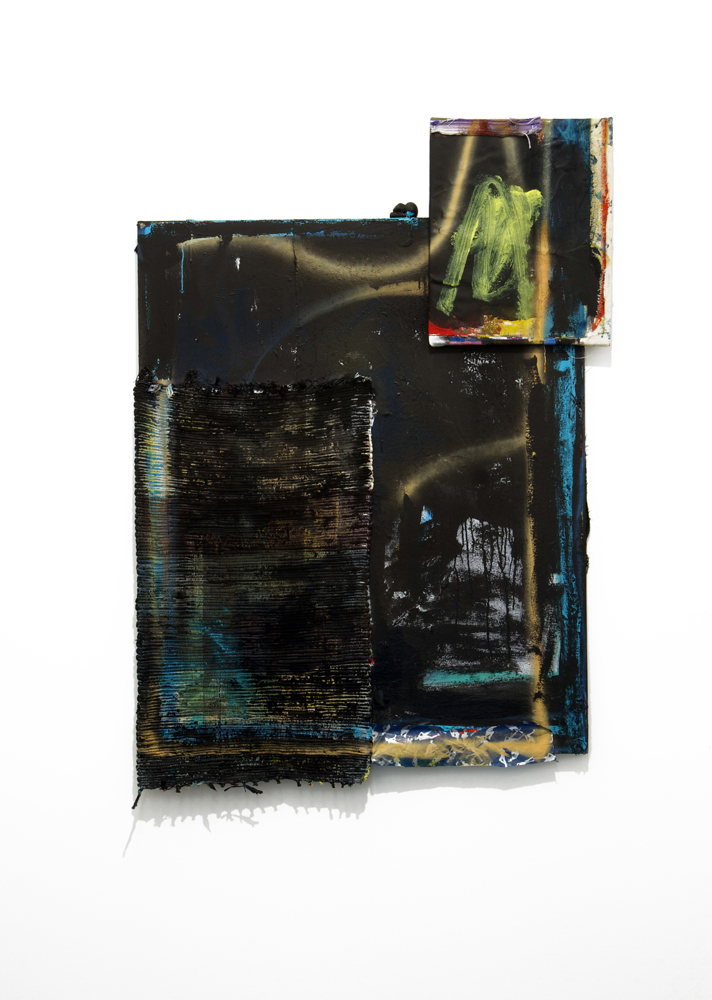Sadie Laska
I KEEP FIGHTING AGAINST THE FRAMEWORK AND THE SHAPE OF THE CANVAS AND WHETHER IT SHOULD ADHERE TO THE STRUCTURE OF A STRETCHED FORM. Sadie Laska
Incorporating detritus from the everyday world into fine art was a modernist tactic, among other strategies, for assaulting the sacred aura of the frame. The 38-year-old West Virginia-born painter Sadie Laska’s deliriously frenetic abstract paintings take what appears to be the opposite approach: She takes quotidian objects—nylon from an umbrella, a headphone cord, a hula-hoop, a bath mat, striped outdoor-furniture fabric—recognizing their texture, weft, and permeability, and integrates them so agilely into her heavily worked (and reworked) surfaces that they become de facto canvases for uneasy merges and strained relations.
A recent graduate of Bard College’s Milton Avery Graduate School of the Arts, Laska began making distinct large-scale expressive abstractions and smaller, less formal collages earlier this year. Her latest process is a hybrid of those projects. “They’re all very layered,” she says. “There are paintings underneath paintings in some cases. I feel like I’m always keeping my options open when I’m working on a piece.”
For their ingredients, Laska’s controlled explosions use previous paintings and other experiments lying around her Williamsburg studio. She might cut out a segment of an earlier painting and suture it into a new work. “I recycle everything,” she says. “I always think, Oh, I can salvage this for something.” Much of the decision-making is accomplished during the process of stretching or wrapping the various canvases onto a frame—with the help of staples and glue. Additional paint—oil, acrylic, spray-paint—is applied overtop, uniting the disparate elements while leaving some of their original qualities in play. “There are some moments of contamination I leave on some of the material,” she explains. “For instance, some of the paint marks might be from when I’ve accidentally stepped on the canvas and left wet paint. Or if there is a shape I’ve cut out that I like, I will go over it again with paint.”
Laska, who might be previously best known as half of the New York sound band I.U.D. with fellow artist Lizzi Bougatsos, takes an almost improvisatory musical process to her paintings, creating dissonance and harmonies inside the structure of a frame. And framing is a device she uses for effect, whether applying the outline of a frame in paint or nailing different-size canvases against each other in box-like grids. In one painting, a fragmented canvas is framed by an old T-shirt, almost like a straight jacket, emphasizing the strain put on enclosure. In other works, the commitment to the rectangle breaks loose. “I keep fighting against the framework and the shape of the canvas and whether it should adhere to the structure of a stretched form,” she says. “Many of the pieces I make end up getting pulled apart again. I’ve accepted that as part of my process—that everything might not come together until the final moment.”
Occasionally Laska’s attempts even defy the rules of traditional craft. “Sometimes I’ll paint with spray-paint on top of wet acrylic and it doesn’t really adhere, so it produces this cracking,” she says. “You’re not supposed to paint over acrylic with anything oil-based, but I like the results it gives.” Laska is putting future conservators on notice.
To return to The New Abstract, click here.







